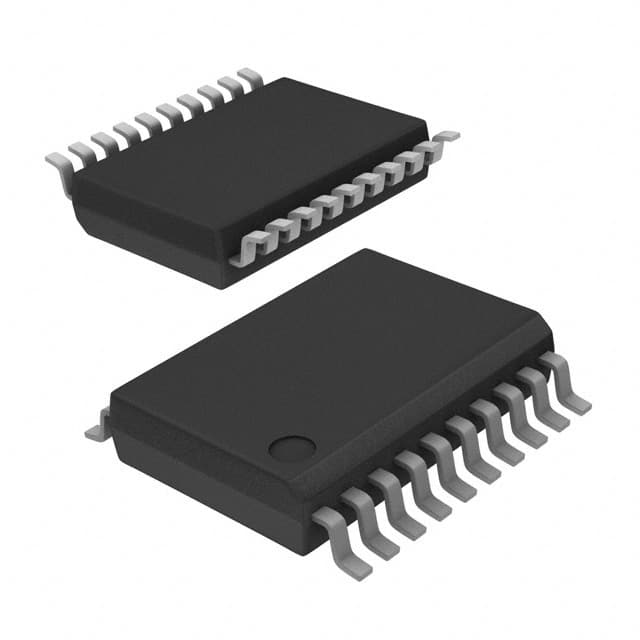74LCX760MSA
Product Overview
- Category: Integrated Circuit (IC)
- Use: Logic Level Translator
- Characteristics: Low Voltage, High-Speed, Bidirectional
- Package: Surface Mount (MSA)
- Essence: Translates logic levels between different voltage domains
- Packaging/Quantity: Tape and Reel, 2500 units per reel
Specifications
- Supply Voltage: 1.65V to 3.6V
- Logic Voltage Levels: 1.8V, 2.5V, 3.3V
- Maximum Data Rate: 400 Mbps
- Number of Channels: 4
- Input/Output Compatibility: TTL, CMOS
- Operating Temperature Range: -40°C to +85°C
Detailed Pin Configuration
The 74LCX760MSA has a total of 20 pins arranged as follows:
___________
| |
1 | 20 | VCC
2 | 19 | OE#
3 | 18 | A1
4 | 17 | B1
5 | 16 | A2
6 | 15 | B2
7 | 14 | GND
8 | 13 | B3
9 | 12 | A3
10 | 11 | B4
|___________|
Functional Features
- Bidirectional voltage level translation between different logic families
- Supports translation between TTL and CMOS logic levels
- Low power consumption
- High-speed operation
- Schmitt trigger inputs for noise immunity
- Output enable control for easy interfacing with other devices
Advantages and Disadvantages
Advantages: - Wide supply voltage range allows compatibility with various systems - Bidirectional translation simplifies interfacing between different logic domains - High-speed operation enables efficient data transfer - Schmitt trigger inputs provide noise immunity
Disadvantages: - Limited number of channels (4) - May not support all possible logic level combinations
Working Principles
The 74LCX760MSA is a bidirectional logic level translator that allows seamless communication between devices operating at different voltage levels. It utilizes a combination of MOSFETs and level-shifting circuitry to convert signals from one logic family to another.
When an input signal is applied to the A-side of the translator, it is converted to the corresponding logic level on the B-side. Similarly, when a signal is applied to the B-side, it is translated to the appropriate level on the A-side. The direction of translation is controlled by the Output Enable (OE#) pin.
The device operates within a specified supply voltage range and provides compatibility between TTL and CMOS logic levels. It also incorporates Schmitt trigger inputs, which ensure reliable operation in the presence of noise.
Detailed Application Field Plans
The 74LCX760MSA can be used in various applications where logic level translation is required. Some potential application fields include:
- Microcontroller interfacing with different voltage peripherals
- Communication interfaces between different logic families
- Level shifting in battery-powered devices
- Signal conversion in mixed-voltage systems
- Industrial automation systems requiring voltage level translation
Detailed and Complete Alternative Models
- SN74LVC1T45DBVR - Single-Bit Dual-Supply Bus Transceiver
- TXB0104PWR - 4-Bit Bidirectional Voltage-Level Translator
- PCA9306DCUR - Dual Bidirectional I2C Bus and SMBus Voltage-Level Translator
- CD40109BE - Quad Level-Shifter with 3-State Outputs
- TXS0104EPWR - 4-Bit Bidirectional Voltage-Level Translator with Automatic Direction Control
These alternative models offer similar functionality and can be considered as alternatives to the 74LCX760MSA based on specific application requirements.
Word count: 525 words
Lista 10 Vanliga frågor och svar relaterade till tillämpningen av 74LCX760MSA i tekniska lösningar
Sure! Here are 10 common questions and answers related to the application of 74LCX760MSA in technical solutions:
Q: What is the 74LCX760MSA? A: The 74LCX760MSA is a low-voltage CMOS (Complementary Metal-Oxide-Semiconductor) 9-bit parity generator/checker with bus-hold capability.
Q: What is the operating voltage range for the 74LCX760MSA? A: The operating voltage range for the 74LCX760MSA is typically between 2.0V and 3.6V.
Q: What is the purpose of a parity generator/checker? A: A parity generator/checker is used to detect errors in data transmission by adding or checking parity bits.
Q: Can the 74LCX760MSA be used in battery-powered applications? A: Yes, the 74LCX760MSA can be used in battery-powered applications due to its low-voltage operation.
Q: How many inputs does the 74LCX760MSA have? A: The 74LCX760MSA has 9 inputs, which are used to input the data bits and the parity bit.
Q: What is the output voltage level of the 74LCX760MSA? A: The output voltage level of the 74LCX760MSA is compatible with both TTL (Transistor-Transistor Logic) and CMOS logic levels.
Q: Can the 74LCX760MSA be cascaded to handle larger data widths? A: Yes, multiple 74LCX760MSA chips can be cascaded together to handle larger data widths by connecting the outputs of one chip to the inputs of another.
Q: Does the 74LCX760MSA have any built-in error detection capabilities? A: Yes, the 74LCX760MSA has a built-in parity checker that can detect errors in the received data.
Q: What is the maximum operating frequency of the 74LCX760MSA? A: The maximum operating frequency of the 74LCX760MSA is typically around 200 MHz.
Q: Can the 74LCX760MSA be used in high-speed data transmission applications? A: Yes, the 74LCX760MSA can be used in high-speed data transmission applications due to its fast propagation delay and high-speed operation.
Please note that these answers are general and may vary depending on the specific application and requirements.


